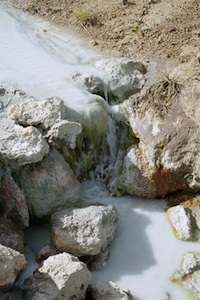
Geothermal exploration is the exploration of the subsurface in search of viable active geothermal regions with the goal of building a geothermal power plant, where hot fluids drive turbines to create electricity. [1] Exploration methods include a broad range of disciplines including geology, geophysics, geochemistry and engineering. [2]
Contents
- Methods of exploration
- Drilling
- Geophysics
- Geochemistry
- US geothermal potential
- See also
- External links
- References
Geothermal regions with adequate heat flow to fuel power plants are found in rift zones, subduction zones and mantle plumes. Hot spots are characterized by four geothermal elements. An active region will have: [1]
- Heat Source - Shallow magmatic body, decaying radioactive elements or ambient heat from high pressures
- Reservoir - Collection of hot rocks from which heat can be drawn
- Geothermal Fluid - Gas, vapor and water found within the reservoir
- Recharge Area - Area surrounding the reservoir that rehydrates the geothermal system.
Exploration involves not only identifying hot geothermal bodies, but also low-density, cost effective regions to drill and already constituted plumbing systems inherent within the subsurface. [3] This information allows for higher success rates in geothermal plant production as well as lower drilling costs.
As much as 42% of all expenses associated with geothermal energy production can be attributed to exploration. These costs are mostly from drilling operations necessary to confirm or deny viable geothermal regions. [4] Some geothermal experts have gone to say that developments in exploration techniques and technologies have the potential to bring the greatest advancements within the industry. [5]
